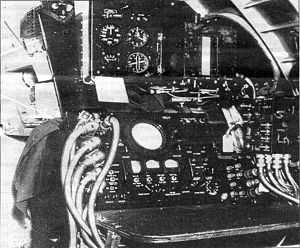H2X radar


H2X radar ("Mickey set", AN/APS-15) was an American development of the British H2S radar, the first ground mapping radar to be used in combat.[1] It was used by the USAAF during World War II as a navigation system for daylight overcast and nighttime operations. It used a shorter 3 cm wavelength (10 GHz frequency) than the H2S, giving a sharper picture (H2S subsequently adopted 3 cm in the Mark III version entering operational service on November 18, 1943, for “Battle of Berlin”) and not known to have ever been spotted by the German Naxos radar detector, due to that receiving device's specific purpose being to spot the original British H2S equipment's lower frequency, 3 GHz emissions. The first H2X-equipped B-17s arrived in England in early February 1944, and were first used in combat later that month. Those missions where bombing was done by H2X were called "Pathfinder missions" and the crews were called "Pathfinder crews". The hemispherical radome for the H2X's rotating dish antenna replaced the ball turret of the Pathfinders. In the B-17 the "Mickey set" was installed in the radio room just aft of the bomb bay. The H2X on later B-24s was installed in the flight deck behind the co-pilot. In combat areas the Mickey operator directed the pilot on headings to be taken, and on the bomb run directed the airplane in coordination with the bombardier. The first use of the "Mickey" was against Ploesti on April 5, 1944.[2]
Due to the absence of radar maps, in late April 1944 six PR Mk.XVI de Havilland Mosquito aircraft in the 482nd Bomb Group were equipped with H2X equipment. The idea was to produce photographs of the radar screen during flights over Germany allowing easy interpretation of these radar images in later bombing runs. Three aircraft were subsequently lost in training, and the project was discontinued. A further twelve PR Mk.XVI de Havilland Mosquito aircraft of the 25th Bomb Group (Reconnaissance) of the Eighth Air Force were fitted with H2X and beginning in May 1944 flew radar mapping night missions until February 1945. The sets tended to overload the Mosquito's electrical system and occasionally exploded. Mickey aircraft had the highest loss, abort, and mission failure rates of the otherwise successful Mosquito reconnaissance aircraft and were severely curtailed after February 19, 1945. Three were lost to enemy action and one was shot down by friendly fire from a Ninth Air Force P-47. In Europe several P-38 fighters were also converted to carrying H2X radar in the nose, along with an operator/navigator to obtain radar maps of German targets but plans to produce the variant in quantity never materialized.
In the Pacific theater, B-29’s were equipped with the improved H2X radar called the AN/APQ-13, a ground scanning radar developed by Bell, Western Electric, and MIT. The radome was carried on the aircraft belly between the bomb bays and was partially retractable. The radar operated at a frequency of 9,375 ± 45 megahertz and used a superheterodyne receiver. The radar was used for high altitude area bombing, search and navigation. Computation for bombing could be performed by an impact predictor. A range unit permitted a high degree of accuracy in locating beacons.
Post-war, the AN/APQ-13 became the first military radar converted to a domestic peacetime application as a storm warning radar. About thirty systems were converted and installed on military bases. It was replaced by the AN/CPS-9 system in 1949.
References
- ↑ Jablonski, Edward (1971). "Volume 2 (Wings of Fire), Book I (Kites over Berlin)". Airpower. p. 49.
- ↑ Miller, Donald L. (2006). Masters of the Air: America's Bomber Boys Who Fought the Air War Against Nazi Germany (html—Google books). New York: Simon & Schuster. p. 118. ISBN 978-0-7432-3544-0.
- Freeman, Roger A. The Mighty Eighth War Diary (1990). ISBN 0-87938-495-6 page 240